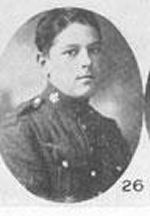Pte
Robert Routledge
Information about birth
|
Date of birth: 01/08/1897 |
|
Place of birth: St. John's, Newfoundland and Labrador, Canada |
General information
|
Last known residence: 32 Charlotte Street, Sydney, Nova Scotia, Canada |
|
Profession: Farmer |
|
Religion: Roman Catholic |
Army information
|
Country: Canada |
|
Force: Canadian Expeditionary Force |
|
Rank: Private |
|
Service number: 715500 |
|
Enlistment date: 25/01/1916 |
|
Enlistment place: Truro, Nova Scotia, Canada |
|
Units: — Royal Canadian Regiment (Last known unit) |
Information about death
|
Date of death: 19/11/1917 |
|
Place of death: No. 44 Casualty Clearing Station, Nine Elms, Poperinge, Belgium |
|
Cause of death: Died of wounds (D.O.W.) |
|
Age: 20 |
Cemetery
|
Nine Elms British Cemetery Plot: IX Row: F Grave: 3 |
Distinctions and medals 2
|
British War Medal Medal |
|
Victory Medal Medal |
Points of interest 5
| #1 | Place of birth | ||
| #2 | Last known residence | ||
| #3 | Enlistment place | ||
| #4 | Place of wounding | ||
| #5 | Place of death (approximate) |
My story
Robert Routledge was born in St John's, Newfoundland in August 1897. His father, Henry Routledge, was on his own after the death of Robert's mother. In 1911, the widower and his four sons, William, Robert, Peter and Angus, rented a room in Styles Lane in Sydney, Nova Scotia. Robert's father emigrated to Newark, New York, in 1915. Robert stayed in Sydney with his youngest brother, Angus, and worked on a farm nearby. In January 1916, he enlisted in Truro, Nova Scotia. He was attached to the 106th Battalion (Nova Scotia Rifles).
On 15 July 1916, they left Canada via Halifax on the ocean liner "SS Empress of Britain" and after 10 days, the recruits arrived in Liverpool. Training continued in England and in October Robert was attached to the 40th Reserve Battalion, in January 1917 to the 26th Reserve Battalion. In March 1917, Robert disembarked in France, where he was absorbed into the ranks of the Royal Canadian Regiment. In October and November 1917, they were at the front at Passchendaele where they took part in the battles around 's Graventafel and Meetcheele. After the offensive died down, they occupied the line north of Passchendaele, around and near Vindictive Crossroads, along the road to Westrozebeke. The Royal Canadian Regiment suffered daily losses. During the day, shelling rolled over the crest of the hill, snipers were active on both sides. Going above ground in broad daylight was enormously dangerous. On 19 November, the regiment left the front at Passchendaele and moved to a camp at Robecq in northern France.
Robert, barely 20 years old, succumbed that same day at Casualty Clearing Station No 44 near Poperinge to a gunshot wound to the abdomen he sustained at the front at Passchendaele. He was buried in Nine Elms British Cemetery.
On 15 July 1916, they left Canada via Halifax on the ocean liner "SS Empress of Britain" and after 10 days, the recruits arrived in Liverpool. Training continued in England and in October Robert was attached to the 40th Reserve Battalion, in January 1917 to the 26th Reserve Battalion. In March 1917, Robert disembarked in France, where he was absorbed into the ranks of the Royal Canadian Regiment. In October and November 1917, they were at the front at Passchendaele where they took part in the battles around 's Graventafel and Meetcheele. After the offensive died down, they occupied the line north of Passchendaele, around and near Vindictive Crossroads, along the road to Westrozebeke. The Royal Canadian Regiment suffered daily losses. During the day, shelling rolled over the crest of the hill, snipers were active on both sides. Going above ground in broad daylight was enormously dangerous. On 19 November, the regiment left the front at Passchendaele and moved to a camp at Robecq in northern France.
Robert, barely 20 years old, succumbed that same day at Casualty Clearing Station No 44 near Poperinge to a gunshot wound to the abdomen he sustained at the front at Passchendaele. He was buried in Nine Elms British Cemetery.
Sources 6
|
McCarthy Chris., Passchendaele. The Day-by-Day Account (London, Unicorn Publishing Group, 2018), 145-159. Sources used |
|
Personnel Records of the First World War (Library and Archives Canada, Ottawa (LAC), RG 150, Accession 1992-93/166, Box 8503 - 61). https://www.bac-lac.gc.ca Sources used |
|
Stuart M.H., the Nova Scotia's part in the Great War (The Naval & Military Press, Uckfield, 2009) 58-64. Sources used |
|
War diaries: Royal Canadian Regiment. (Library and Archives Canada, Ottawa (LAC), RG9-III-D-3,Volume number: 4911, Microfilm reel number: T-10703, File number: 344a ). http://central.bac-lac.gc.ca Sources used |
|
War Graves Registers: Circumstances of Death (Library and Archives Canada, Ottawa (LAC), RG 150, 1992-93/314; Volume Number: 234). https://library-archives.canada.ca/ Sources used |
|
War Graves Registry: Commonwealth War Graves (Library and Archives Canada, Ottawa (LAC): RG150, 1992-1993/314, Box 39-244; Box: 117). https://library-archives.canada.ca/ Sources used |
More information 4
|
Commonwealth War Graves Commission Database https://www.cwgc.org/find-records/find-war-dead/casualty-details/137394 |
|
Namenlijst (In Flanders Fields Museum) https://namenlijst.org/publicsearch/#/person/_id=fdd6d557-f9dd-4099-be65-a9f91f6a6278 |
|
The Canadian Virtual War Memorial https://www.veterans.gc.ca/eng/remembrance/memorials/canadian-virtual-war-memorial/detail/137394 |
|
Lives of the First World War (Imperial War Museum) https://livesofthefirstworldwar.iwm.org.uk/lifestory/6089304 |
